What is missing from the Indian Healthtech startups ecosystem?
- Suman Jha
- Jun 25
- 3 min read
When you think about the Indian healthcare market, healthtech seems to be the most lucrative, but still, most healthtech struggle to make any dent. The root cause could be the lack of microinnovations.
Most startups focus on advanced technology, large innovation, and the top 5% of Indians and get stuck - make slow or no progress. However, the pace of progress is not by large and original innovation, it is the implementation of original innovation at scale by microinnovating in the journey.
Let’s take two examples:
First Example:
Edison neither invented electricity nor the electric light nor the lightbulb. In 1800, the Italian physicist Alessandro Volta reportedly built the first battery with an electric current. In 1809, Humphry Davy built the first practical “arc lamp” that sent a span of sparks across two rods. In 1841, the English inventor Frederick de Moleyns was granted the first patent for a charcoal-powered incandescent lamp.
So, why do we give credit of the lightbulb to Edison? It is because Edison understood the problem of implementation at scale. He understood that, to make electric light useful, there must be a continuous flow of electricity, so he microinnovated wires to carry electricity. He microinnovated the stable lightbulb filament, generators, sockets, switches to turn it on and off, meters to measure usage and allow billing of customers. All these microinnovations combined made the electric light useful.
Example Second:
OpenAI did not invent the Transformer model that powers the Large Language Model (LLM) like ChatGPT. It was invented by Google in 2017 in the influential paper “Attention is all you need”. OpenAI microinnovated the natural language use case with a simple chat interface, long followed by Better Data and token, Scaling laws, fine-tuned methods such as few-shot learning, etc.
Zerodha is also an example of microinnovations across the journey. The first microinnovation was a flat fee that came from personal observations because the founders were traders (being on the ground).
Edison, OpenAI, and Zerodha did not innovate the original technology, but solved the problem of scaling new technology by microinnovating in the journey. If we consider India’s healthtech market and startups, most are focusing on the original innovation, which is a solved problem.
Can any of us build a better foundational LLM model than global counterparts? Can any of us build a better vertical model than global AI companies and Labs? The likely answer is no. But can any of these companies solve the problem of scaling these LLM models of vertical models that could make this technology useful for healthcare across the continuum in India? Again, the answer is likely no?
If this is the case, then the real question comes out - who is solving the problem of implementing this technology at scale and making it useful for a billion humans? Unfortunately, solving these problems demands thinking in micro, not in macro.
Let me give you one example:
How many days a startup will take to build an Artificial Intelligence-based “Health Risk Engine” that could predict Chronic Health risks based on primary health Vitals, Habits/Lifestyle, and demographics with 85% accuracy that could be used for pre-screening? Maybe one day? But will that bring any progress in India’s healthcare delivery? No.
The progress in India’s healthcare delivery system will come by Clinical Study of the AI-based Health Risk Engine, getting CDSCO class B certification under Software as a Medical Device (SaMD), implementation of population-scale screening, building of large data sets, and using these data sets as a wedge to integrate diagnosis and IPD datasets - building of Longitudinal Health Records.
Once there are longitudinal health records of individuals, it will be possible to build AI use cases for evidence-based healthcare delivery, connect each healthcare continuum, bring down healthcare delivery costs, and make quality healthcare affordable.
All these microinnovations demand leveraging of available resources - human and infrastructure. But this is a hardwork on the ground and unfortunately, not many of us are not ready to do that. This is also not a sexy work like sitting in front of a computer, sometimes, it demands taking your laptop sit in a public park, screen and asking questions to understand.
Fortunately, we have been building in Patna and microinnovating on many fronts. We definitely have a long way to go, but after years of work, we have a sense of the opportunity and a blur path.
There is a lot of fun in writing without any assistant in the ChatGPT world. :) Thanks for reading.

